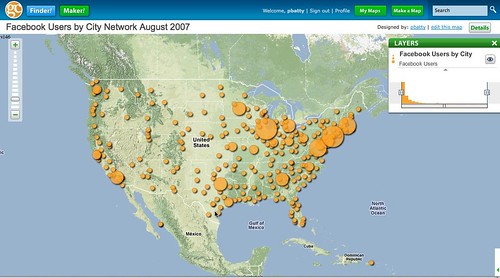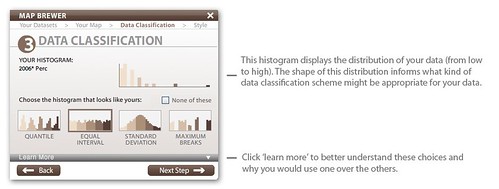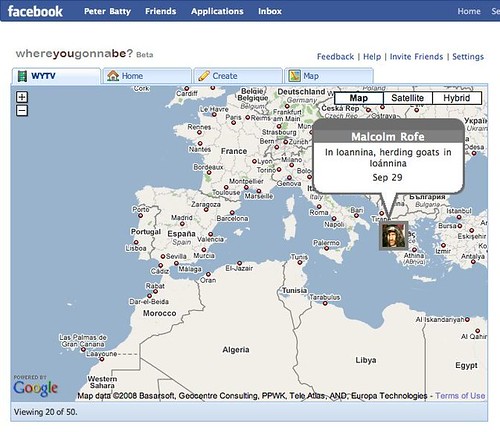I have
alluded previously to some interesting developments going on in very high performance spatial analytics, and today the
official announcement went out about
Netezza Spatial (after being pre-announced via Adena at
All Points Blog and
James Fee).
For me, the most impressive aspect of today at the Netezza User Conference was the presentation from Shajy Mathai of Guy Carpenter, the first customer for Netezza Spatial, who talked about how they have improved the performance of their exposure management application, which analyzes insurance risk due to an incoming hurricane. They have reduced the time taken to do an analysis of the risk on over 4 million insured properties from 45 minutes using Oracle Spatial to an astonishing 5 seconds using Netezza (that’s over 500x improvement!). Their current application won the
Oracle Spatial Excellence “Innovator Award” in 2006. About half of the 45 minutes is taken up loading the latest detailed weather forecast/risk polygons and other related data, and the other half doing point in polygon calculations for the insured properties. In Netezza the data updates just run continuously in the background as they are so fast, and the point in polygon analysis takes about 5 seconds. For insurance companies with billions of dollars of insured properties at risk, this time difference to get updated information is hugely valuable. The performance improvement you will see over traditional database systems will vary depending on the data and the types of analysis being performed - in general we anticipate performance improvements will typically be in the range of 10x to 100x.
Netezza is a company I have been very impressed with (and in the interests of full disclosure, I am currently doing some consulting work for them and have been for several months). They have taken a radically different approach to complex database applications in the business intelligence space, developing a “database appliance” – a combination of specialized hardware and their own database software, which delivers performance for complex queries on large (multi-terabyte) databases which is typically 10 to 100 times faster than traditional relational database architectures like Oracle or SQL Server. There are two primary means by which they achieve this level of performance. One is by highly parallelizing the processing of queries – a small Netezza configuration has about 50 parallel processing units, each one a powerful computer in its own right, and a large one has around 1000 parallel units (known as Snippet Processing Units or SPUs). Effectively parallelizing queries is a complex software problem – it’s not just a case of throwing lots of hardware at the issue. The second key element is their smart disk readers, which use technology called Field Programmable Gate Arrays (FPGAs), which essentially implement major elements of SQL in hardware, so that basic filtering (eliminating unwanted rows) and projection (eliminating unwanted fields) of data all happens in the disk reader, so unnecessary data is never even read from disk, which eliminates a huge bottleneck in doing complex ad hoc queries in traditional systems.
Apart from outstanding performance, the other key benefit of Netezza is significantly simpler design and administration than with traditional complex database applications. Much of this is due to the fact that Netezza has no indexes, and design of indexes and other ongoing performance tuning operations usually take a lot of time for complex analytic applications in a traditional environment.
Netezza’s technology has been validated by their dramatic success in the database market, which in my experience is quite conservative and resistant to change. This year they expect revenues of about $180m, growth of over 40% over last year’s $127m. About a year ago, Larry Ellison of Oracle
said in a press conference that Oracle would have something to compete with Netezza within a year. This is notable because it’s unusual for them to mention specific competitors, and even more unusual to admit that they basically can’t compete with them today and won’t for a year. Given the complexity of what Netezza has done, and the difficulty of developing specialized hardware as well as software, I am skeptical about others catching them any time soon.
So anyway (to get back to the spatial details), the exciting news for people trying to do complex large scale spatial analytics is that Netezza has now announced support for spatial data types and operators – specifically vector data types: points, lines and areas. They support the OGC standard SQL for Simple Features, as well as commonly used functions not included in the standard (the functionality is similar to PostGIS). This enables dramatic performance improvements for complex applications, and in many cases lets us answer questions that we couldn’t even contemplate asking before. We have seen strong interest already from several markets, including insurance, retail, telecom, online advertising, crime analysis and intelligence, and Federal government. I suspect that many of the early users will be existing Netezza customers, or other business intelligence (BI) users, who want to add a location element to their existing BI applications. But I also anticipate some users with existing complex spatial applications and large data volumes, for whom Netezza can deliver these substantial performance improvements for analytics, while simplifying adminstration and tuning requirements.
One important thing to note is that Netezza is specifically
not focused on "operational" geospatial applications. The architecture is designed to work effectively for mass queries and analysis - if you are just trying to access a single record or small set of records with a pre-defined query, then a traditional database architecture is the right solution. So in cases where the application focus is not exclusively on complex analytics, Netezza is likely to be an add-on to existing operational systems, not a replacement. This is typical in most organizations doing business intelligence applications, where data is consolidated from multiple operational systems into a corporate data warehouse for analytics (whether spatial or non-spatial).
Aside from the new spatial capabilities, the Netezza conference has been extremely interesting in general, and I will post again in the near future with more general comments on some of the interesting themes that I have heard here, including "providing information at the speed of thought"!
Having worked with interesting innovations in spatial database technologies for many years, from IBM's early efforts on storing spatial data in DB2 in the mid to late eighties, to Smallworld's innovations with long transactions, graphical performance and extreme scalability in terms of concurrent update users in the early nineties, and Ubisense's very high performance real time precision tracking system more recently, it's exciting to see another radical step forward for the industry, this time in terms of what is possible in the area of complex spatial analytics.


